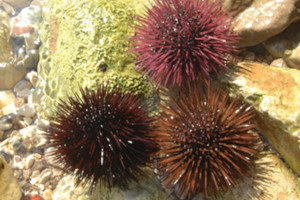Generalities
For over a century, the sea urchin has been used as a model organism in evolutionary studies and developmental biology. Indeed, the echinoderms phylum is the closest to that of chordates, and the development of the sea urchin is very singular: it develops according to a bilateral embryonic plan but in the adult state has a body with a radial plan. In recent years, many studies have been directed towards their ecology and ecotoxicology.
Researchers’ enthusiasm for sea urchins is also due to their ease of harvesting and rearing in the laboratory, and other ease of handling: among them,the ability to obtain a very large number of gametes, the transparency of eggs, embryos and larvae, or the possibility of artificial fertilization.
The sea urchin Paracentrotus lividus (family Echinidae) is the main edible species in the Mediterranean and north-east Atlantic. It is one of the most widely used echinoderm models. Development of molecular tools and techniques allowing the silencing or forced expression of certain genes in Paracentrotus lividus allows the analysis of gene networks whose activity is essential during development.
Genome sequencing of the species Strongylocentrotus purpuratus, commonly known as the purple sea urchin, shows that sea urchins share many genetic similarities with humans. These data now reinforce the use of sea urchins, particularly in cellular and molecular biology, but also for studies on human diseases.
- Name : Strongylocentrotus purpuratus
- Phylogenetic classification: echinoderm, family Strongylocentrotidae
- Genome sequencing complete since 2006 (Sea Urchin Genome Sequencing Consortium)
-
Genome size : 814 millions bp.
Number of genes : about 23,000
- Name : Paracentrotus lividus
- Phylogenetic classification: echinoderm, family Strongylocentrotidae
- Genome currently being sequenced
Reproduction
Sexes are separated and gonads look the same in both sexes. Some are hermaphroditic. Reproductive cells are released synchronously in certain seasons. As spawning approaches, the urchins congregate and the gametes are released directly into the water where fertilization takes place. In laboratory, carrying out fertilization outside the spawning season is an easy task.
Tools
- Functional analysis of developmental genes by injection of morpholino antisense oligonucleotides (gene silencing) or by microinjection of synthetic mRNA (gene overexpression)
- Promoter dissection by ″phylogenetic footprinting″ (inter-species comparison of regulatory sequences) and by in vivo functional tests.
- Genomic approaches such as microarrays.
- Cell imaging.
Databases
Genomic databases:
http://www.echinobase.org/Echinobase/
https://www.hgsc.bcm.edu/other-invertebrates/sea-urchin-genome-project
http://www.genome.jp/dbget-bin/www_bfind
(Strongylocentrotus purpuratus): https://metazoa.ensembl.org/Strongylocentrotus_purpuratus/Info/Annotation/
Pesticide Action Network (PAN) database:
http://www.pesticideinfo.org/
Infrastructures
- UMR « Modèles en biologie cellulaire et évolutive » - UMR 7628-Observatoire Océanologique de Banyuls)
- https://wwwphp.obs-banyuls.fr/
- Banyuls
- Laboratoire de cycle cellulaire et développement
- http://www.sb-roscoff.fr/
- Roscoff
- Groupe de Christian Sardet Laboratoire « BioMarCell »
-
UMR 7009 CNRS/UPMC -
Equipe Fécondation et contrôle du cycle méiotique, groupe d’Alex McDougall
Equipe BioMarCell : Fécondation et polarisation des embryons d’invertébrés marins, groupe de Christian Sardet
Equipe Spécification des précurseurs embryonnaires, groupe de Hitoyoshi Yasuo - Villefranche-sur-mer
Experts
- Thierry LEPAGE
- lepage@obs-vlfr.fr
- UMR7009 CNRS/UPMC, Villefranche-sur-Mer
Bibliography
- Articles
“SpBase: the sea urchin genome database and web site.” Cameron RA, Samanta M, Yuan A, He D and Davidson E., Nucleic Acids Research. 2009 Jan;37(Database issue):D750-4. DOI: 10.1093/nar/gkn887.
“The sea urchin’s siren”, Pederson, developmental biology, 2006
“The Genome of the Sea Urchin Strongylocentrotus purpuratus”, Sea Urchin Genome Sequencing Consortium, et al., science, 2006
- Websites
